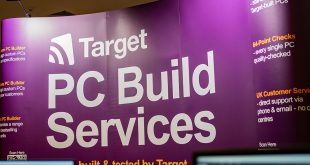Distributor Target Components has published its fourth ShopTalk Retail Price Comparison (RPC) report – and once again its data provides valuable insight into the IT retail industry.
To recap, the RPC is an annual survey of independent bricks and mortar IT retail businesses across the UK and Ireland – 171 stores took part in 2015, up 47 per cent over 2014.
Its purpose, according to Target, is to improve the sustainability of the independent IT retail sector, ultimately by helping businesses set prices fairly.
Here’s how it works in a nutshell: participants provide their typical in-store prices and sales satisfaction across a range of products and services. Separately, the lowest online prices from select multiples, such as PC World, are included.
The resulting report combines all that data.
Pricing variances with other participants are used to structure the report, while comparisons with multiples are also presented for context.
As you would expect, the RPC is a weighty tome, so we’re going to break the 2015 results down into bitesized summaries of the key findings for you…
INDIES CONTINUE TO OFFER BETTER VALUE (FOR NOW)
IMAGE – Table 3.1 from report
The big ‘take home’ from the latest RPC is that while independent retailers continue to offer better value than multiples, their advantage is reducing – it was just two per cent in 2015, compared to nine per cent in 2014.
CAN’T GET NO SATISFACTION?
According to the RPC, average sales satisfaction from indie retailers dipped by 2.15 per cent compared to 2014 levels, but remained higher than reported in both 2013
and 2012.
However, the proportion of products on which indies rated sales satisfaction as “ok or better” rose for the third successive year to 78 per cent. The report concludes that this is because indie retailers have enjoyed increasing sales over the last three years.
PRICE ELASTIC, NOT FANTASTIC
The RPC indicates that independent retailers are still getting their pricing wrong, with two thirds under-pricing by 15 per cent on average, compared to the free market. The thinking is that indies use lower prices in order to better compete, but the reality is that low pricing actually fails to improve sales.
Put simply, the data indicates that consumers choose indies because of their expertise and trustworthiness – and are prepared to pay. By setting prices low, indie retailers are unnecessarily devaluing their position in the market.
For example, the RPC data suggests indie retailers selling at the highest prices are charging a significant premium, yet achieving a higher level of sales satisfaction than those who discount heavily.
The results contradict conventional thinking regarding price elasticity for the second successive year, i.e. higher sales at higher prices, with clear ‘negative elasticity’ evident.
MORE IS DEFINITELY BETTER
IMAGE – Table 6.1 from survey
The average range stocked by indie retailers has broadened – from 40 products in 2012 to 47 in 2015.
In fact, in 2015 indies continued to offer a wider range than multiples generally. Although PC World consistently offered more (with 52 product types), half of indie participants offered as wide or a wider range than the giant. This is a significant shift from 2013, when only 25 per cent of indies offered a broader range than PC World.
KEY CONCLUSIONS, SWIFT ACTIONS
The RPC is quite clear on what the action points from the survey should be for indies: increased marketing and price optimisation. Clearly there is a paradox between survey results that show indies are better priced than multiples and the consumer perception that they are not.
Target Components says that although not borne out directly by the survey results, discussions with its customers point to a disconnect when it comes to marketing.
Multiples operate sophisticated sales and marketing strategies in concert with complex pricing structures. Conversely, independent IT specialists are niche businesses often run by computer enthusiasts with little or no marketing experience. The result is little if any apparent competition in the eyes of the consumer.
The RPC asserts that consumer perceptions of indie pricing and value will only alter once retailers start to market more visibly and compete assertively using their inherent competitive advantages (expertise, passion, personal service, knowledge, accountability) and price advantages where they have it.
Moreover, the report concludes that the precarious circumstances some indies endure could be, at least partly, self-imposed by their approach to pricing.
As highlighted above, low pricing can depress sales as much as high, sparking a vicious circle of ever decreasing prices failing to materialise in sales, leading to further price reductions.
But there’s still some good news. Counterintuitively, the RPC says the most encouraging result from the data is the narrowing of price advantage discussed above – down to two per cent in 2015 from 12 per cent in 2012. The report says that while this is partly the result of increasingly aggressive price promotions from the multiples, there is good reason to attribute some of this to price increases from indies.
You can download the full ShopTalk Retail Price Comparison 2015 report, with full data, references and appendices, from www.targetcomponents.co.uk.
 PCR Tech and IT retail, distribution and vendor news
PCR Tech and IT retail, distribution and vendor news




